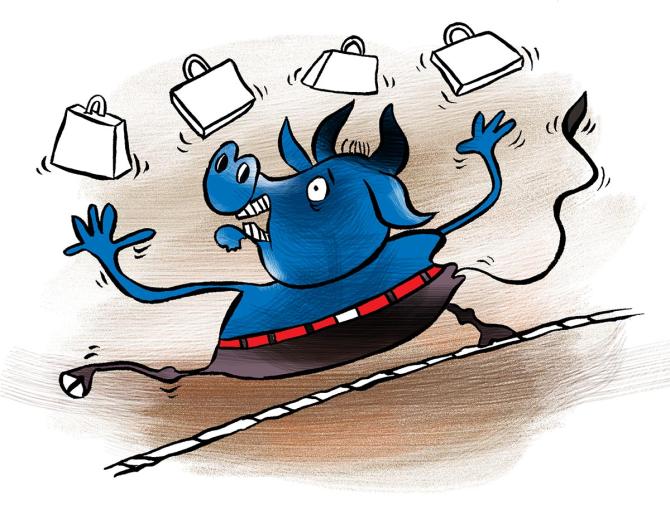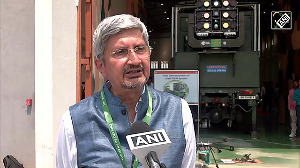'Consider 40% to 50% in equities, 10% in gold as a hedge, and the remaining 30% to 40% split between multi-asset funds and hybrid funds.'

"Accept that market volatility is normal -- it's not volatility itself that's the problem, but rather the anxiety about volatility that causes pain," Ashish Shanker, MD and CEO, Motilal Oswal Wealth, tells Prasanna D Zore/Rediff.com.
How do you look at this Budget from the point of view of fiscal consolidation and economic growth, with fiscal deficit capped at 4.4%?
The Budget strikes a brilliant balance. They've maintained a healthy increase in capital expenditure when combining central and state allocations.
Instead of increasing welfare spending, which might have been tempting given recent elections, they've provided relief to middle-class taxpayers. This is the highest ever capex Budget in absolute terms.
They have managed fiscal discipline by avoiding excessive welfare spending and moderating capex increases.
The Budget also includes significant ease of business improvements through reduced regulations and reforms in establishment acts.
In percentage terms, the capex has increased by 10.1%, which some consider a sore point. What's your view?
The 10% growth should be viewed in context. The government has already substantially increased capex in the previous two years, so this moderate increase helps manage fiscal targets.
In absolute terms, it remains a significant amount. One has to look at everything in context, and given the substantial work done on capex in the last two years, this growth rate is appropriate.
How will this capex increase impact economic growth, and which sectors will benefit most?
We can expect two main developments. First, the government will likely accelerate capex spending to clear existing backlogs, especially from here to June, as spending has been slow in the first half.
Second, the tax relief should boost discretionary consumption rather than staples. The impact will be more pronounced in discretionary sectors like automotive, real estate, jewellery, and digital consumer platforms like Zomato and Swiggy.
These sectors should benefit as more money reaches middle-class consumers, who are the primary users of these services and products.
Moving to a fiscal deficit of 4.4%, is this a significant achievement?
Yes, it's a very good achievement considering global conditions, especially compared to other countries like the US.
If you look at the US balance sheet and certain other countries, India has done remarkably well in managing its fiscal consolidation.
Will this translate into reduced interest rates?
The RBI has already begun responding by increasing system liquidity. Direct rate cuts are challenging due to the US rate cycle timing and rupee depreciation concerns. The focus is on ensuring adequate system liquidity through repo auctions.
Additionally, government spending will help improve liquidity through multiplier effects.
When money moves from government to private corporates or individuals, there's an automatic money multiplier effect that benefits the system.
The economic survey projects 6.3% to 6.5% GDP growth. Could we exceed this?
It's unlikely to exceed these projections.
We have to see what's happening globally and in India. Except for the US, there are growth challenges everywhere -- China faces growth challenges, the European Union has growth challenges, and even the US might struggle to maintain growth.
I would budget for around 6% growth. With 4% to 5% inflation, we're looking at nominal growth of 10-11%, which is still good considering global conditions.
The tax rebate will result in a Rs 1 lakh crore revenue loss for the government. Will this boost private consumption?
While it's tough to predict household behaviour, my sense is that consumption patterns, especially in metros, have evolved significantly over the last three to four years. People are more inclined toward spending and instant gratification.
The impact will be magnified through EMI-based purchases -- for every rupee of tax benefit, NBFCs might enable 7-8 rupees of spending through financing.
So we should see both spending and savings increase, with a particular boost to discretionary spending.
Which sectors will benefit most from Budget allocations?
Infrastructure, particularly roads, will continue to see strong focus and spending.
Real estate should benefit significantly, and we should see increased allocations to the electricity sector.
Defence will continue to do well because of the thrust on Make in India, with many indigenous companies benefiting from domestic manufacturing initiatives.
Additionally, PSUs with strong cash balances can drive additional capex beyond direct government spending.
Will Indian equities remain attractive for FIIs given current valuations?
Large-cap stocks, particularly the Nifty 50, remain attractive. They are trading below their 10-year average multiple, under 21 times forward earnings.
Despite perception, the Nifty's one-year return is currently zero after recent rupee depreciation, and it's not among the top-performing indices.
The key is future profit growth, but large caps are not overvalued.
Smaller and mid-sized companies are undergoing consolidation after three strong years. While the Nifty gained 8% to 9% last year, mid and small caps averaged 25% to 26% growth, creating a large disparity.
P/E (price to earnings) multiples expanded significantly. Mid-caps now trade around 27-28 times earnings and small caps at 30-31 times after the recent correction. This correction or consolidation phase may last five to six months.
However, these companies have also experienced substantial earnings growth (25% to 40% over the past few years), justifying some P/E re-rating.
Profit-booking is occurring, but overall valuations may not be excessive.
How will potential Trump trade policies and resultant trade wars impact Indian markets?
It's difficult to predict the impact because, logically, the US imports most of its goods from China, Mexico, India, and Vietnam, while energy comes primarily from Canada and the Middle East.
If Trump imposes tariffs, it will make goods more expensive for Americans, leading to inflation. This could force the US Fed to be cautious, making the strategy self-defeating.
It appears to be a strategic move to bring companies to negotiate. If Trump's end game is to get companies to manufacture in the US, the challenge is that US production is more expensive.
While he might match this cost difference with tariffs, many products are labour-intensive, and it's questionable whether the US has the required workforce.
The good news is that India won't be significantly affected since we are not major players in US manufacturing imports. Our strength lies in services and software exports, which could actually benefit if the US economy performs well.
While tariffs on China might make Indian goods more competitive, we face capacity constraints. The question is whether we can scale up manufacturing quickly enough to replace Chinese exports.
That said, the overall impact of trade wars on India should be neutral to beneficial, especially considering our bilateral relationship includes significant revenue from Indian students in US universities and our strong domestic demand-led economy.
How should retail investors position themselves given the Budget and global risks?
I believe portfolios need to be balanced this year.
Within the FMCG sector, investors should avoid being overweight as valuations in certain areas are already stretched.
However, I would recommend increasing exposure to consumer discretionary if your portfolio lacks sufficient allocation in this sector.
Banks, particularly private banks, should perform well as they have managed to maintain good liquidity. Banks are reasonably priced, especially consumer-facing banks. For example, Bajaj Finance is positioned to benefit significantly due to its focus on consumer loans. Consumer-facing banks and the consumer discretionary sector both show promise.
Digital consumer companies should also perform well. Eventually, I expect capital market stocks to show good performance too. Overall, the outlook is positive.
Regarding pharma, it's very stock-specific, so I can't make broad sector recommendations.
These are the key themes I would focus on. I suggest tilting portfolios more towards consumer sectors if they are currently underweight, and towards banks, since many investors have been underweight in banking stocks for the past two years.
For asset allocation, consider 40% to 50% in equities, 10% in gold as a hedge, and the remaining 30% to 40% split between multi-asset funds and hybrid funds.
Most importantly, accept that market volatility is normal -- it's not volatility itself that's the problem, but rather the anxiety about volatility that causes pain.
Disclaimer: This article is meant for information purposes only. This article and information do not constitute a distribution, an endorsement, an investment advice, an offer to buy or sell or the solicitation of an offer to buy or sell any securities/schemes or any other financial products/investment products mentioned in this article to influence the opinion or behaviour of the investors/recipients.
Any use of the information/any investment and investment related decisions of the investors/recipients are at their sole discretion and risk. Any advice herein is made on a general basis and does not take into account the specific investment objectives of the specific person or group of persons. Opinions expressed herein are subject to change without notice.
Feature Presentation: Ashish Narsale/Rediff.com











 © 2025
© 2025